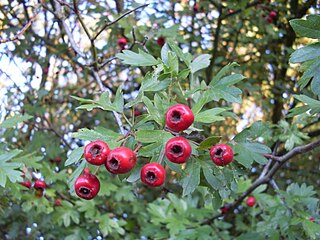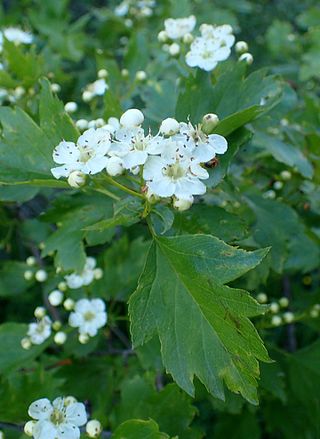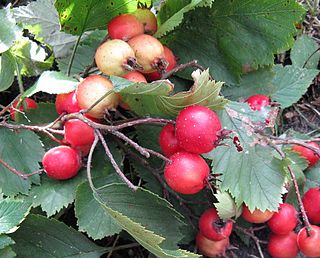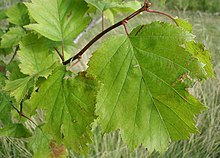
Crataegus, commonly called hawthorn, quickthorn, thornapple, May-tree, whitethorn, Mayflower or hawberry, is a genus of several hundred species of shrubs and trees in the family Rosaceae, native to temperate regions of the Northern Hemisphere in Europe, Asia, North Africa and North America. The name "hawthorn" was originally applied to the species native to northern Europe, especially the common hawthorn C. monogyna, and the unmodified name is often so used in Britain and Ireland. The name is now also applied to the entire genus and to the related Asian genus Rhaphiolepis.

Crataegus monogyna, known as common hawthorn, one-seed hawthorn, or single-seeded hawthorn, is a species of flowering plant in the rose family Rosaceae. It is native to Europe, northwestern Africa, and West Asia, but has been introduced in many other parts of the world.
Crataegus flava, common names summer haw and yellow-fruited thorn, is a species of hawthorn native to the southeastern United States from Virginia to Florida, west to Mississippi. Due to an error by Sargent the name C. flava was, and often still is, used for a different species C. lacrimata, which belongs to a different series, the Lacrimatae series. Flavae is another group of species that were thought to be related to the misidentified C. flava, and although it is now apparent that they are not related, the name of the group remains. Because the true identity of this species has only recently been discovered, the name is rarely used correctly. Individuals with red fruit occur; these have sometimes been assigned to a separate species, Crataegus senta.
Crataegus biltmoreana is a species of hawthorn native to the Southeastern United States. It is one of many hawthorn species named by Chauncey Delos Beadle when he worked at the Biltmore Estate. The fruit are green, yellow, or orange. It is sometimes considered to be a synonym of C. intricata.
Crataegus boyntonii is a species of hawthorn native to the southeastern United States. Its fruit are "yellow-green flushed with red". It is sometimes considered to be a synonym of Crataegus intricata.
Crataegus coccinioides is a species of hawthorn known by the common names Kansas hawthorn and large-flowered cockspurthorn. Crataegus coccinioides is native from Kansas, to New England, and the southernmost parts of Ontario and Quebec. It has large flowers and leaves and fruit that appear pinkish until polished to reveal the red colour underneath the wax bloom. Crataegus coccinioides is a synonym of Crataegus dilatata.

Crataegus crus-galli is a species of hawthorn known by the common names cockspur hawthorn and cockspur thorn. It is native to eastern North America from Ontario to Texas to Florida, and it is widely used in horticulture. It is thought to be the parent, along with Crataegus succulenta, of the tetraploid species Crataegus persimilis.

Crataegus × lavalleei, sometimes known as hybrid cockspurthorn or Lavallée's hawthorn, is a hybrid that arose between cultivated specimens of two species in the genus Crataegus (Hawthorn). It is an ornamental small tree with glossy dark green unlobed leaves that is used horticulturally.

Crataegus nigra, the Hungarian thorn, Hungarian hawthorn or black hawthorn, is a black-fruited species of hawthorn native to the western balkan and the Pannonian Basin, spanning from Slovakia to Albania. The fruit, which is up to 10 mm across, can be consumed fresh or cooked.

Crataegus orientalis, known as oriental hawthorn, is a species of hawthorn native to the Mediterranean region, Turkey, Caucasia, Crimea, and western Iran, with fruits that are orange or various shades of red.

Crataegus punctata is a species of hawthorn known by the common names dotted hawthorn or white haw that is native to most of the eastern United States and eastern Canada. While some sources claim it is the state flower of Missouri, the actual legislation does not identify an exact species. Furthermore, the Missouri Department of Conservation asserts the Crataegus mollis was specifically designated as the state flower.

Crataegus submollis, known as the northern downy hawthorn, northern red haw, Quebec hawthorn, or hairy cockspurthorn, is a species of hawthorn that grows to about 7 m in height and typically carries large crops of red fruit.

Crataegus succulenta is a species of hawthorn known by the common names fleshy hawthorn, succulent hawthorn, and round-fruited cockspurthorn. It is "the most wide-ranging hawthorn in North America", native to much of southern Canada, and the United States as far south as Arizona, New Mexico, Kansas, Missouri, North Carolina, and Tennessee. In this wide area there are many variant forms that have received species names, but can also be considered as synonyms. It is thought to be the parent, along with Crataegus crus-galli, of the tetraploid species Crataegus persimilis.

Crataegus viridis, the green hawthorn or southern thorn, is a species of hawthorn that is native to the southeastern United States. The tree tends to grow to be 5–15 meters tall. Forms vary considerably, and many desirable ornamental forms could be selected from the wild. The cultivar 'Winter King' is a well-known selection.

Crataegus mexicana is a species of hawthorn known by the common names tejocote, manzanita, tejocotera and Mexican hawthorn. It is native to the mountains of Mexico and parts of Guatemala, and has been introduced in the Andes. The fruit of this species is one of the most useful among hawthorns.
Crataegus visenda is a species of hawthorn from the southeastern United States, in Alabama, Florida, and Georgia. It is a large shrub or small tree to 10 m tall. It has been considered as a synonym of Crataegus flava Aiton

Crataegus coccinea, the scarlet hawthorn, is a species of hawthorn around which there is considerable confusion because the name has been misapplied for a long time. It has been shown to be the same as C. pedicellata, and under the rules of botanical nomenclature, the older name should be used.

Crataegus pulcherrima is a species of Hawthorn native to the southeastern United States. This species and those related to it that are classified in Crataegus series Pulcherrimae have been largely ignored since they were originally described in 1903, but warrant consideration as ornamental cultivated plants.
Crataegus dilatata is a species of hawthorn known by the common names broadleaf hawthorn and apple-leaf hawthorn. Crataegus dilatata is native from New York to New England, and the southernmost parts of Ontario and Quebec. They grow to a height of 20 feet (6.1 m). The leaves are 2 to 2.5 inches long, broadly ovate, short pointed at the tip, notched or rounded at the base, coarsely doubly saw-toothed and usually with several shallow lobes. The Latin name means "dilated" or "spread out" which describes the broad leaves.

Crataegus nitida, the glossy hawthorn or shining hawthorn, is a species of flowering plant in the family Rosaceae, native to the US states of Illinois, Missouri and Arkansas. Hardy to USDA zone 5, it is useful in landscaping applications where a small, showy tree with thorns is desired.














